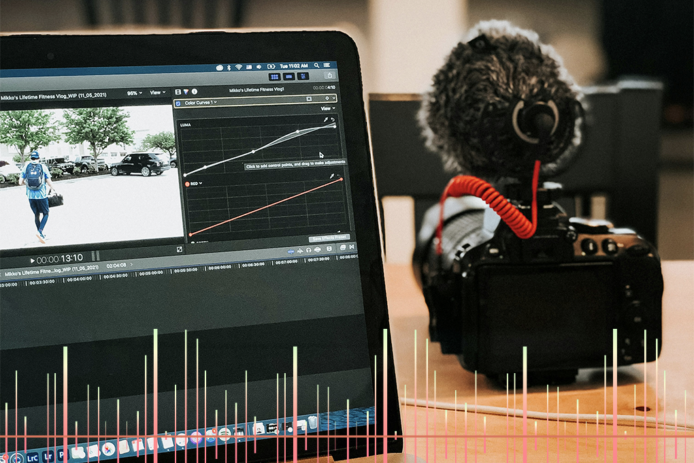Becoming a transcriptionist is a promising career path that offers flexibility, allowing you to work from home or on the go. It’s an ideal option for those with strong typing skills and a keen ear for detail.
Transcriptionists are in demand across various industries, from legal to medical to general transcription services. This article will introduce you to the essential steps to start your journey, including the skills you need to develop, the equipment required, and how to find work in this growing field.
Whether you’re looking to switch careers or supplement your income, transcription could be the perfect fit. Keep reading to learn how you can transform your typing skills into a fulfilling and profitable career as a transcriptionist.
Key Takeaways
- Transcriptionists convert audio into written documents, requiring strong typing, listening, and language skills across various industries.
- Specializing in areas like medical, legal, or academic transcription can lead to higher pay but may require additional training or certification.
- Essential equipment includes a reliable computer, high-speed internet, quality headphones, and optional tools like a foot pedal for efficiency.
- Gaining experience through entry-level jobs, volunteering, or internships is crucial for building a portfolio and improving transcription skills.
- Freelance platforms, transcription companies, networking, and direct outreach are key methods to find transcription work, especially for beginners.
- Transcription is a viable part-time gig, but with industry saturation and AI advancements, it’s best suited as supplementary income rather than a primary career.
What is Transcription?
Transcription is the process of converting spoken words from audio or video recordings into written text. This service bridges the gap between audio content and accessible written documents, making information available to a broader audience and creating searchable, permanent records of spoken content.
What is a Transcriptionist?
A transcriptionist listens to audio or video recordings and types out the spoken content to create an accurate written document. This involves carefully listening to the audio, understanding the context and speaker’s intent, and transcribing the words verbatim or with light editing as required by the client.
Transcriptionists must have excellent typing skills, attention to detail, and the ability to understand various accents, dialects, and technical terminology. They may work with a wide range of content, including interviews, podcasts, webinars, legal proceedings, medical dictations, and more.
The work of a transcriptionist makes spoken information accessible in a readable format, which is valuable for various purposes, such as creating subtitles, documenting meeting minutes, generating written records of legal proceedings, or repurposing audio/video content into blog posts or articles.
What are the Benefits of Becoming a Transcriptionist?
While becoming a transcriptionist may not be most people’s ideal career path, there are various perks to becoming one.
1. Work-Life Balance and Flexibility
One of the most attractive benefits of becoming a transcriptionist is the ability to work from anywhere with an internet connection. You can set your own schedule, work during hours that suit your lifestyle, and balance professional responsibilities with personal commitments. This flexibility makes transcription an excellent option for parents, students, or anyone seeking better work-life integration.
2. Low Startup Costs
Unlike many other careers, transcription requires minimal upfront investment. You likely already own most of the necessary equipment: a computer and an internet connection. The main additional purchases are quality headphones and possibly transcription software, making this one of the most accessible career paths to enter.
3. Skill Development Opportunities
Working as a transcriptionist helps you develop valuable transferable skills, including improved typing speed, better listening abilities, enhanced grammar and language skills, and increased knowledge across various industries. These skills can benefit you in many other professional contexts.
4. Steady Income Potential
While transcription is not the kind of career that can make you a six-figure income, it offers reliable income opportunities. Experienced transcriptionists can build long-term relationships with clients, leading to consistent work and predictable earnings. Many professionals use transcription as a stepping stone to other writing or editing careers or even as a way to make extra money on the side.
5. Diverse Work Content
Transcription work exposes you to a wide range of subjects and industries. One day you might transcribe a medical conference, the next a business podcast, and the following day an academic lecture. This variety keeps the work interesting and continuously expands your knowledge base.
Common Types of Transcription
As a transcriptionist, you can specialize in various areas, each with its unique requirements and skill set.
1. General Transcription
This involves transcribing audio or video content from diverse fields, such as interviews, podcasts, webinars, and meetings. General transcriptionists must be adaptable and able to work with a wide range of topics and industries.
2. Medical Transcription
Medical transcriptionists convert medical reports, doctor’s notes, and patient records into written documents. This specialty requires knowledge of medical terminology, anatomy, and pharmacology. Attention to detail is paramount, as accuracy is crucial in medical documentation.
3. Legal Transcription
When working in legal transcription, you’ll work with court proceedings, depositions, and legal documents. Familiarity with legal terminology and procedures is necessary. Transcripts must be verbatim and adhere to specific formatting guidelines.
4. Academic Transcription
This involves transcribing lectures, research interviews, and academic content. Academic transcriptionists may encounter complex terminology and need to understand the subject matter they’re working with. Accuracy and clarity are essential to ensure the transcripts are useful for students and researchers.
When choosing a specialization, consider your interests, background, and skills. Some specialties, like medical or legal transcription, may require additional training or certification. However, specializing can lead to higher-paying opportunities and a more focused career path.
As a beginner, starting with general transcription can help you gain experience and exposure to various content types. This can help you identify areas of interest and decide if you want to specialize in the future.
Skills Required for Transcription
If you’re looking to start a career as a transcriptionist, here are some of the best skill sets you can have to maximize your chances of success.
Keep in mind that not all of these will be necessary to become a transcription expert. However, possessing these skills will set you apart from other individuals, which is definitely necessary in a field as saturated as transcription.
1. Typing Proficiency
Transcriptionists must type quickly and accurately, often achieving speeds of 70-90 words per minute or higher. Practicing typing regularly can help you improve your speed and accuracy.
2. Excellent Listening Skills
You’ll need to be able to listen carefully to audio recordings, often with background noise, accents, or multiple speakers. This requires focus, concentration, and the ability to discern words and phrases accurately.
3. Language Proficiency
A strong command of grammar, spelling, and punctuation in the language you’re transcribing is essential. Familiarity with various dialects, accents, and regional variations is also beneficial.
4. Attention to Detail
Transcriptionists must be meticulous in their work, ensuring that the written document accurately reflects the audio content. This involves carefully reviewing and proofreading your work for errors or inconsistencies.
5. Time Management
As a transcriptionist, you’ll often work with deadlines. Effective time management skills are necessary to ensure that you complete projects on time while maintaining high-quality work.
6. Computer Literacy
Proficiency with word processing software, such as Microsoft Word or Google Docs, is essential. You may also need to be comfortable using transcription software or online platforms.
7. Research Skills
Depending on the content you’re transcribing, you may encounter unfamiliar terms, names, or concepts. Being able to research and verify information quickly is a valuable skill.
8. Adaptability
Transcriptionists work with diverse content across various industries. The ability to adapt to different subjects, styles, and formats is important for success in this field.
How Much Does a Transcriptionist Make?

So, we mentioned that transcriptionists aren’t making six figures, but how much are they actually making? Here’s a breakdown of what transcriptionists make through their career.
Entry-Level Transcriptionist Salary
Beginning transcriptionists typically earn between $10-$15 per hour when starting out. Your initial earnings will depend on factors like typing speed, accuracy, and the platforms you choose to work with. Many new transcriptionists start with companies like Rev or TranscribeMe, which offer much lower rates but provide steady work to build experience and keep you from having to search for clients on your own.
Experienced Transcriptionist Earnings
After gaining experience and building a client base, transcriptionists can earn $18-$25 per hour for general transcription work. Those who specialize in medical or legal transcription, often with degrees in these fields, command higher rates, sometimes earning $25-$40 per hour due to the specialized knowledge required.
Factors Affecting Transcriptionist Pay
Several factors influence how much money you can make as a transcriptionist:
- Audio Quality: Clear recordings allow for faster transcription and higher hourly earnings
- Turnaround Time: Rush jobs typically pay premium rates
- Specialization: Medical, legal, and technical transcription pays more than general work. Direct clients usually pay better than transcription companies
- Experience Level: Veteran transcriptionists can charge higher rates
- Geographic Location: Rates may vary based on regional market conditions
Full-Time vs Part-Time Income Potential
Working full-time (40 hours per week) as an experienced transcriptionist could potentially generate $35,000-$50,000 annually. However, most transcriptionists work part-time due to the demanding nature of the work and market saturation. Part-time transcriptionists often earn $500-$1,500 per month, making it an excellent supplemental income source.
Maximizing Your Transcription Income
To increase your earning potential as a transcriptionist, focus on improving your typing speed, specializing in higher-paying niches, building direct client relationships, and maintaining high accuracy rates. Consider using professional transcription tools like Sonix to speed up your workflow; while AI tools handle the initial transcription, your expertise in editing and quality control becomes even more valuable.
Step-by-Step Guide on Becoming a Transcriptionist
Now that we’ve gotten some of the fundamental information out of the way, here are the steps you need to take to become a successful transcriptionist.
1. Decide What Types of Transcription Jobs You’re Interested In
Before starting transcription work, take time to research different specialization areas and determine which align with your interests and background. Consider your current knowledge base; for instance, if you have medical experience, medical transcription might be a natural fit. If you enjoy legal content or have studied law, legal transcription could be ideal.
Start by examining job postings on various platforms to understand the requirements and pay rates for different types of transcription work. General transcription offers the most opportunities for beginners, while specialized fields require additional training but offer higher compensation.
2. Practice Your Typing Skills or Pursue Advanced Training
Assess your current typing speed using free online tools like TypingTest.com or Keybr.com. Most transcription jobs require a minimum of 60-70 words per minute, though faster speeds (80+ WPM) will significantly increase your earning potential.
If your typing speed needs improvement, dedicate 30-60 minutes daily to typing practice. Focus on accuracy first, then speed; fixing errors takes more time than typing slower but correctly. Consider investing in ergonomic equipment like a comfortable keyboard and a proper chair to prevent strain during long typing sessions.
For specialized transcription areas, pursue relevant training or certification programs. Medical transcription may require courses in anatomy and medical terminology, while legal transcription benefits from understanding legal procedures and terminology.
3. Prepare Your Resume
Create a targeted resume that highlights relevant skills for transcription work. Emphasize your typing speed and accuracy, attention to detail, language proficiency, and any relevant experience with audio or writing work.
Include specific metrics when possible; mention your exact typing speed, accuracy percentage, and any certifications you’ve earned. If you have experience in fields related to your chosen transcription specialty (healthcare, legal, education), make sure to highlight this background.
Consider creating a professional portfolio with sample transcriptions to demonstrate your skills. You can create samples by transcribing publicly available audio content, such as TED Talks or podcast excerpts.
4. Apply to Transcription Jobs
Start your job search with entry-level opportunities at established transcription companies. These companies often have structured training programs and steady workflow, making them ideal for beginners.
Research each company’s requirements, pay structure, and application process before applying. Some companies require you to pass tests before being accepted, while others offer paid training programs.
As you gain experience, gradually transition to freelance platforms and direct client work, which typically offer better pay rates but require more self-marketing and client management skills.
5. Get Familiar With the Company’s Style Guide
Each transcription company or client will have specific formatting requirements and style preferences. Common style considerations include:
- How to handle speaker identification
- Whether to include filler words like “um” and “uh”
- Punctuation and capitalization rules
- Time stamp formatting requirements
- How to indicate unclear audio or multiple speakers
Spend time thoroughly studying these guidelines before starting your first project. Consistent adherence to style requirements is often more important than speed when you’re building your reputation with a new client or company.
6. Take a Typing Test
Most transcription companies require you to pass a typing test as part of their application process. These tests typically measure both speed and accuracy, often requiring minimum scores like 70 WPM with 95% accuracy.
Prepare for these tests by practicing with transcription-specific typing challenges, which include listening to audio while typing rather than copying existing text. This skill is quite different from regular typing and requires practice to master.
Some companies also include grammar and punctuation tests, so review basic English language rules before applying. Consider taking practice tests available online to familiarize yourself with the format and expectations.
7. Make Sure You Have the Required Tech
While there are minimal tech requirements for working as a transcriptionist, some are non-negotiable, and some will make you better and faster at your job.
First off, your computer should have sufficient processing power to handle audio playback and text editing simultaneously. Most transcription work requires at least 8GB of RAM and a reliable internet connection for downloading files and submitting completed work.
- Professional Headphones: Invest in high-quality, noise-canceling headphones designed for transcription work. Over-ear headphones typically provide better sound isolation than earbuds, allowing you to catch subtle details in audio recordings. Budget at least $50-$100 for quality headphones.
- Transcription Software and Tools: While some companies provide their own software, having your own transcription tools gives you more flexibility. Consider professional solutions like Sonix, which offers AI-powered transcription with 99% accuracy across 53+ languages. This can significantly speed up your workflow by providing an initial draft that you can edit rather than starting from scratch.
- Foot Pedal (Optional but Recommended): A foot pedal allows you to control audio playback without using your hands, keeping them free for typing. This tool can improve your efficiency and reduce the strain of constantly switching between keyboard and mouse to pause or rewind audio.
- Backup and Security Measures: Set up automatic file backups and ensure your internet connection is stable. Many transcription jobs involve confidential information, so consider using encrypted storage solutions and secure file transfer methods when required by clients.
Where to Find Transcription Jobs as a Beginner
Struggling to land your first job? As a new transcriptionist, there are several ways to find work and start building your career.
Freelance Platforms
Websites like Upwork, Freelancer, and Fiverr connect freelance transcriptionists with clients who need their services. Create a profile, showcase your skills, and bid on projects that match your expertise.
Transcription Companies
Many companies specialize in providing transcription services to clients across various industries. Some popular options include Rev, TranscribeMe, and GoTranscript. These companies often have a steady stream of work and can be a good starting point for new transcriptionists. These businesses outsource their client files to freelancers from across the globe. However, even though technically you’ll still be a freelancer, the payout will be a little less than what you’ll earn from being an independent contractor.
Networking
Building relationships with other professionals in your field can lead to job opportunities and referrals. Join online communities, participate in forums, and attend industry events to expand your network.
Direct Outreach
As you gain experience, consider reaching out directly to potential clients who may need transcription services. This could include businesses, podcasters, YouTubers, or researchers. Develop a professional website or portfolio to showcase your skills and attract clients.
Specialization
As you progress in your career, consider specializing in a particular area of transcription, such as legal, medical, or academic transcription. Specialization often requires additional training or certification but can lead to higher-paying opportunities.
Final Thoughts – Should You Become a Transcriptionist?
Becoming a transcriptionist can be an appealing side hustle, especially if you enjoy working independently and have strong attention to detail. The flexibility to work from home and set your own hours makes it an attractive option for those seeking extra income.
However, the transcription industry has become increasingly saturated, with many competing for the same jobs. This high level of competition often leads to lower pay rates and fewer steady opportunities, making it difficult to rely on transcription as a full-time career.
Apart from that, due to the advanced Automated Speech Recognition (ASR) technology available right now, AI transcription tools are becoming more and more accurate with tools like Sonix reaching up to 99% accuracy. Human transcriptionists are at an increasing risk of being replaced by AI.
While it can be a rewarding part-time gig at the moment, it’s best viewed as a supplementary income source rather than a primary profession.
Looking for an AI-assistant to speed up your workflow with 99% accuracy? Try out Sonix with a 30-minute free trial. No credit card required.
How to Become a Transcriptionist: Frequently Asked Questions
How Long Does It Take to Become a Transcriptionist?
The timeline varies by individual. With consistent daily practice and the right tools, a beginner can start accepting basic transcription jobs within 2–4 weeks. However, mastering advanced formatting, industry-specific language, and achieving high typing speeds may take 3–6 months. Medical and legal transcription roles typically require more time due to their specialized vocabulary and formatting standards.
Do I Need a Certification to Become a Transcriptionist?
Certification is not required but can provide an advantage. Reputable courses often include training in grammar, formatting, and sector-specific vocabulary, making candidates more competitive. Certified transcriptionists may qualify for better-paying jobs and are often prioritized for complex tasks. Programs from organizations like AAERT or specialized medical/legal transcription courses can improve credibility with employers.
How Much Can I Earn as a Transcriptionist?
Transcription pay varies widely. Entry-level transcriptionists often earn between $10–$15 per hour. With experience, strong typing speed, and specialization in areas like medical or legal transcription, earnings can rise to $25–$30 per hour or more. Freelancers may earn more per job, while full-time staff transcriptionists may have steadier but capped income.
What Equipment Do I Need to Start Transcribing?
Essential tools include a reliable computer, fast internet connection, a comfortable noise-canceling headset, and transcription software like Sonix. Many professionals also use a USB foot pedal to control audio playback efficiently. Optional tools like text expanders and grammar software can also improve speed and accuracy for long-term transcription work.
How Can I Find Transcription Jobs as a Beginner?
Beginners can start by registering on freelance platforms (like Upwork or Fiverr), transcription marketplaces (such as Rev or TranscribeMe), and company portals that hire entry-level transcribers. Building a small portfolio with samples, taking typing and grammar tests, and learning basic transcription guidelines helps establish credibility and secure initial opportunities.
World's Most Accurate AI Transcription
Sonix transcribes your audio and video in minutes — with accuracy that'll make you forget it's automated.






